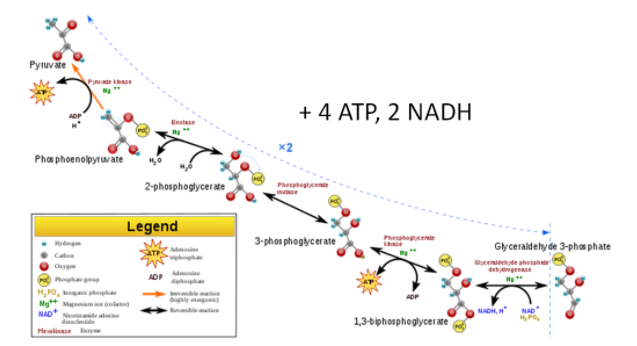17.3.1: Glycolysis
- Page ID
- 36331
If a person is in a catabolic state or in need of energy, such as during fasting, glucose will be used for glycolysis.
Glycolysis is the metabolic process of breaking down of one glucose molecule (6 carbons) into two pyruvate molecules (3 carbons). During this process, a net of two ATPs and two NADHs are also produced.

Figure 9.3.4.1 Glycolysis1
3 steps of Glycolysis
1. Energy investment step - 2 ATP are added to the 6 carbon molecule.

Figure 9.3.4.2 Glycolysis step 1, energy investment1
2. Glucose Split - The 6 carbon molecule is split into two 3 carbon molecules.

Figure 9.3.4.3 Glycolysis step 2, glucose split1
3. Energy harvesting step - 1 NADH and 2 ATPs are produced from each 3 carbon molecule (there are two 3 carbon molecules formed from each glucose).

Figure 9.3.4.4 Glycolysis step 3, energy harvesting1
Thus, from a molecule of glucose, the harvesting step produces a total of four ATPs and two NADHs. Subtracting the harvesting from the investment step, the net output from one molecule of glucose is two ATPs and two NADHs.3
The figure below shows the stages of glycolysis, as well as the transition reaction, citric acid cycle, and electron transport chain that are utilized by cells to produce energy. They are also the focus of the next 3 sections.

Figure 9.3.4.5 Glycolysis, transition reaction, citric acid cycle, and the electron transport chain2
Video Animation
If the above was 'too techy' for you, please watch this short video:
Contributors
Brian Lindshield and Claudia Kelley
References & Links
- en.Wikipedia.org/wiki/File:Glycolysis.svg
- en.Wikipedia.org/wiki/File:CellRespiration.svg
- Berg JM, Tymoczko JL, Stryer L. Biochemistry. 5th edition. New York: W H Freeman; 2002. Section 16.1, Glycolysis Is an Energy-Conversion Pathway in Many Organisms. Available from: https://www.ncbi.nlm.nih.gov/books/NBK22593/

